Glossary of Japanese Calligraphy Terms
This is a glossary of Japanese Calligraphy terms and terms used throughout this website.
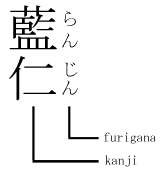
Furigana 振り仮名 are small phonetic characters, often hiragana, written beside the kanji to give the correct reading. furigana is used for difficult to read words or names, and in children’s books furigana is used to teach the child to learn kanji.
When the text is written vertically, the furigana is written to the right. When writing horizontally, the furigana is above the kanji.
The example on the right shows the kanji for a Chinese poet whose name probably cannot be read by many Japanese. With the furigana the reader knows the proper reading which in this case is ranjin.
Gairaigo 外来語 refers to a Japanese word of foreign origin. Today, katakana is used exclusively to write borrowed words or names.
One common example is the Japanese word for bread is パン (read pan) which comes from French. Another is チェフ (read shefu) which means Chef and comes from the French/English.
Gyousho 行書 (Semi-cursive Scripts) means a range of semi-cursive scripts that can go from almost block to almost cursive. Gyousho is a simplified and softer form of kaisho but not as terse as the often difficult to read sousho.
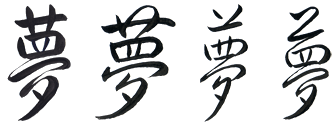
Examples of Dream 夢 (yume)
in different gyousho fonts by Eri Takase
Today gyousho is used almost exclusively in Japanese Calligraphy. Originally, it was used by everyone as a faster way to write and today one still sees older Japanese using semi-cursive scripts in everyday writing as a convenient form of shorthand.
Hentaigana 変体仮名 is a group of phonetic syllabary based on kanji and an early form of hiragana. Hiragana was not standardized until the 1900s and what predates modern hiragana is a mixture of kanji and hiragana used to phonetically render some words and grammatical elements.
The Kokinshu (c. 920) was the first major anthology of Japanese poetry in Japanese in contrast to the previous Manyoshu which celebrated the Japanese fascination with the Chinese language and Chinese poetry. All of the poems in the Kokinshu are written in hentaigana. Below is an example of one of my favorite poems by Lady Ise:
い可耳ま知見む
束之婦とも
棠つぬる悲と毛
あらしと於毛へ盤
ika ni machimimu
toshi fu tomo
tazunuru hito mo
araji to omoeba
how it longs for your coming –
Miwa Mountain for
it knows there will be no
visitors though long years pass
Somes examples of hentaigana from the poem are omoeba which today is written 思えば. In this poem, it is written 於毛へ盤. Another example is the word “person” today is written 人 (hito) though in this poem, it is written 悲と. And, finally, beginning Japanese students know that the kanji for “mountain” is 山 (yama), but here it is written や万. Strange, right? Hence the name 変体 hentai (strange) 仮名 gana (syllabary).
The same poem in modern Japanese would be written more like:
三輪の山
いかに待ち見む
年ふとも
たづぬる人も
あらじと思えば
Hiragana 平仮名 is one of the two modern Japanese syllabaries. Hiragana was also called 女手 onna de or “feminine-hand” indicating its enthusiastic adoption by the female poets in the Heian period. Today hiragana is used with kanji to write most of the Japanese language. Nouns and the base of verbs and adjectives use kanji and the suffixes indicating tense and gender (for example) are written in hiragana. Also hiragana is commonly used when furigana is required and is used for grammatical particles. In contrast, katakana today is used exclusively to write non-Japanese words and names.
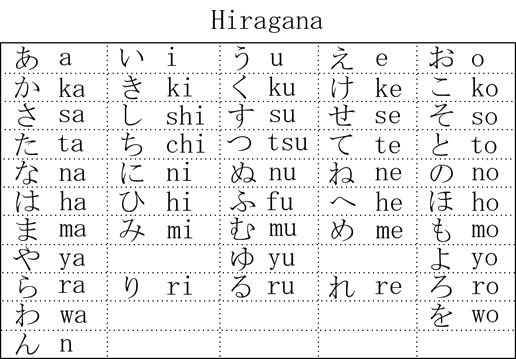
 Kaisho 楷書 (Block Scripts) are an angular form of writing Chinese characters. Today, kaisho scripts are the most commonly used and most recognized.
Kaisho 楷書 (Block Scripts) are an angular form of writing Chinese characters. Today, kaisho scripts are the most commonly used and most recognized.
On the right is an example of the character for 夢 “dream” which has the on’yomi (Chinese reading) of mu and the kun’yomi
(Japanese reading) of yume (pronounced “you may”). For a comparison of the different style for writing this character see the section on kanji.
Kana 仮名 refers to both katakana and hiragana. Kana may also refer to the archaic man’yougana and hentaigana.
Kanji 漢字 are Japanese symbols originally from China that, in many cases, have been significantly modified to write the Japanese language. Kanji, like Egyptian hieroglyphics, were originally pictographs or ideographs. Introduced to Japan starting around the fourth century from China via Korea, kanji has undergone changes over the millennia to better accommodated writing the very different Japanese language.
Dream (yume) 夢 in the five main scripts
by Eri Takase

The image above shows examples of the main style of writing kanji. It is very important to note that each is not a single style but a group of styles. There is not one semi-cursive script, rather there are many.
The above example uses the character for the word “dream” or yume (pronounced “you may”). The block script or kaisho is the most commonly seen today and is what one sees in newspapers and magazines.
Tensho 篆書
(Seal Scripts) are used for the name seals that Japanese use instead of a signature (these are the red stamps that appear on Japanese calligraphy).Kaisho 楷書 (Block Scripts) are the most typical form of the kanji and is the form of the kanji used in everyday life.
Reisho 隷書 (Clerical Scripts) are a simplified version of the kanji that is dominated by horizontal and vertical lines. Originally this was a pejorative style used by slaves and the lesser educated. This simplified style is now often used only for newspaper names and in stone carving (e.g. grave markers).
Gyousho 行書 (Semi-cursive Scripts) are a simplified and softer form of the kaisho script and today is used almost exclusively in Japanese Calligraphy. Originally, the gyousho font was used as a faster way to write kanji and even today gyousho is sometimes used by older Japanese in everyday writing as a form of shorthand. The gyousho style can be read, for the most part, by all Japanese.
Sousho 草書 (Cursive Scripts) are the most abstract and, in my opinion, the most aesthetically pleasing. The word sousho combines two Chinese characters: 草 sou meaning “grass” and 書 sho meaning “writing”. Thus sousho is often translated directly as “grass writing” or “grass script” and looking at Japanese calligraphy works in this style, one cannot but notice the dominance of near vertical lines looking very much like grass. While very beautiful, this style is very difficult to read even for specialists.
All of the above styles for kanji also appear in Chinese calligraphy. What distinguishes Japanese Calligraphy from Chinese Calligraphy is the use of hiragana and katakana. Often times it is the use of hiragana that makes Japanese Calligraphy unique and special and gives Japanese Calligraphy an artistic dimension not found in its Chinese counterpart.
Note that each of the five script categories (tensho, kaisho, reisho, gyousho, and sousho) represent a group of fonts. There is not one tensho font, but many. The same is true for all the scripts. It is this range that makes Japanese Calligraphy both artistically appealing and intellectually challenging.
Kasure 掠れ is a type of stroke where it looks like the brush is running out of ink. In this stroke, there is much movement and one can see the subtle colors that are in the ink.
Katakana 片仮名 is one of the two modern Japanese syllabaries. Each symbol represents a syllable (not a letter) and the symbols have no meaning – they simply represent a sound. Katakana is used exclusively for words and names borrowed from other languages and is the standard syllabary for writing non-Japanese names in Japanese.
Each katakana character is a simplified form or a part of a kanji character. Katakana’s creation is attributed to the monk scholar Kibi no Makibi (AD 693-755) and was the first syllabary developed. Initially, it was used as a pronunciation aid for Buddhist scriptures. Later katakana was used to write grammatical and inflectional elements. Today katakana is used to write non-Japanese words, names, and technical terms in Japanese.
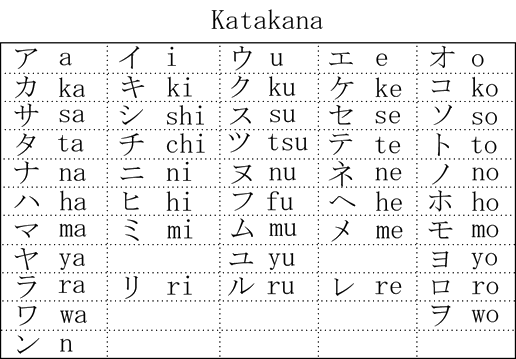
Kun’yomi 訓読み (Japanese Reading) is a kanji reading where the native Japanese word is used. When Chinese characters were adapted to write Japanese, sometimes the Chinese pronunciation was used and a new word was created. Other times, the kanji was read using the native Japanese word.
One common example is the kanji 山 which has the kun’yomi yama and the on’yomi san. So we often hear Mt. Fuji referred to as fujiyama and fujisan and both are valid readings of 富士山.
Another example is the kanji 姉 is read ane meaning “older sister”. ane is the kun’yomi. In contrast, the word sisters 姉妹 is read shimai. Here 姉 is read shi which is an on’yomi or Chinese reading of the character.
Because each kanji can have several different readings, this makes learning to read Japanese difficult.
On’yomi 音読み (Chinese Reading) When Chinese characters were adopted to write Japanese sometimes the original Chinese pronunciation was used. As this adoption happened over hundreds of years and
from different parts of China a single kanji can have several different on’yomi depending on when and from where in China the word came from. In contrast kun’yomi are words that retain the original Japanese word.
Reisho 隷書 (Clerical Scripts) is a simplified version of the tensho script that is dominated by horizontal and vertical lines. This is sometimes called the “Clerical Script” and in the Han Dynasty (206BC – 220AD) served to simplify the tensho script and therefore make it more appropriate for practical purposes. The overall shape is rectangular with a height to width ration of two to three. Today this simplified version of the tensho style is used only for newspaper names and in stone carving (e.g. grave markers).
Rice Paper is not only not made from rice, it is not even, strictly speaking, paper. Rice paper is made from the pith of the Fatsia papyrifera tree. This material is used in Chinese paintings, however, it is never used in traditional Japanese calligraphy. Traditionally, Japanese calligraphy uses Washi (Japanese paper).
Romaji ローマ字 is a system of writing Japanese using English letters. Romaji means “roman characters” and is written ローマ字 with ローマ ro-ma meaning “Rome” and 字 ji meaning “characters”.
There are two accepted systems: 1) kunrei shiki 2) Hepburn system. Briefly the kunrei shiki would write Fuji as huzi while the Hepburn system is what we see today writing Fuji as fuji. This website uses the Hepburn system.
Romaji does not have capital letters. Hiragana, katakana, and kanji have no way to indicate a capital letter and so capital letters do not exist in romaji. However, in English sentences it is customary to capitalize words that start a setence and we follow this convention even if the word is in romaji.
Also romaji is correctly written roma-ji with the extended vowel. However, for clarity we will use the incorrect romaji on this website.
Shihan 師範 (Master) The world of Japanese Calligraphy has ranks much like the Martial Arts. The first rank is the tenth kyu with the highest kyu rank being the first kyu. The next highest rank is shodan which is the Martial Arts equivalent of a first degree black belt. Unlike most Martial Arts ranking systems, the title of shihan can only be awarded after reaching and passing the 10th dan which is the highest dan ranking.
In the world of Japanese calligraphy, the rank of shihan is a rare and prestigious rank. Among the privileges of this rank is the right to open one’s own school and teach one’s own style of calligraphy. Throughout this website, one can see examples of Master Takase’s unique style.
Shikishi 色紙 is Japanese paper mounted on a thick board with a gold border. Shikishi come in many different sizes. The standard size is 9 1/2″ W x 10 3/4″ H. Also shikishi are about 1/8″ thick. Another common size is the mini-shikishi which is 4″ W x 5 7/8″ H.
Shodo 書道 (Japanese Calligraphy) or more properly shodou is Japanese Calligraphy. Literally the kanji mean “the way of writing”.
Sousho 草書 (Cursive Scripts) are the most abstract and is considered the most aesthetically pleasing style. The word sousho combines two Chinese characters: sou meaning “grass” and sho meaning “script”. Thus sousho is sometimes translated as “grass script” and looking at calligraphy done in this style, one cannot but notice the dominance of near vertical lines looking very much like grass.
 B.jpg)
Example of a 草書 sousho script by Eri Takase
Syllabary is a set of characters where each character represents a syllable (as opposed to a single letter). Japanese is not written with letters as is English. Rather Japanese is a language of syllables and so hiragana and katakana characters each represent a syllable.
Tanzaku 短冊 is Japanese paper mounted thick board with a gold border. Tanzaku come in two standard sizes: 2 3/8″ W x 14 1/4″ H and 3″ x 14 1/4″. An example of a tanzaku with a holder is shown below.

Tensho 篆書 (Seal Scripts) are the earliest form of Chinese characters that goes back to the Qin Dynasty (221BC – 206BC). The tensho script uses a single stroke width, are roughly rectangular with a height to width ratio of three to two and has a feeling of expressionless refinement. Today tensho script is used for seals that the Chinese and the Japanese use instead of a signature (these are the red stamps that appear on Chinese and Japanese art and in everything from legal forms to routine business documents).
Washi 和紙 (Japanese paper) is made from the Japanese 楮 kouzo, みつまた mitsumata, and 雁皮 gampi plants. It is a common misunderstanding that Japanese calligraphy is done on rice paper. Some Chinese art uses rice paper, but Japanese calligraphy is done exclusively on washi.
If you would like to learn more about washi we have two excellent articles on the making of Japanese paper at Hiroyuki Fukunishi Japanese Papermaker and The Diplomas of Ryoma Elementary School.
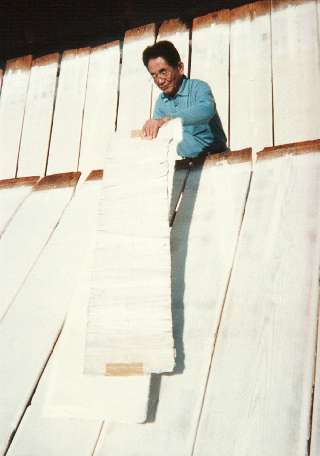
Hiroyuki Fukunishi Japanese Papermaker
Living National Treasure